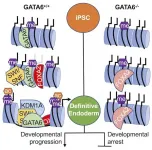Financial toxicity impacts nearly 50% of women with gynecologic cancer
To cope with costs, patients report medication non-adherence which may lead to worse health outcomes
2021-06-14
(Press-News.org) BOSTON - The cost of cancer care in United States was an estimated $183 billion in 2015 and is projected to rise by 30 percent by 2030, according to the American Cancer Society. While private and government insurance may cover much of the cost of care, even patients with insurance can struggle to pay for office visit co-payments, prescription medications or other cancer-related expenses. Yet limited data describes how financial hardship impacts patient behavior and how that in turn may impact patient health.
In a new study designed to provide a more comprehensive picture of how a diverse cohort of gynecologic cancer patients are affected by financial distress -- also called "financial toxicity" in acknowledgment of the health hazards it can pose -- researcher-physicians at Beth Israel Deaconess Medical Center (BIDMC) and the University of Alabama at Birmingham (UAB) analyzed previously collected survey data of gynecologic oncology patients from their respective institutions. Their findings are reported in the International Journal of Gynecological Cancer.
"To broaden our understanding of financial toxicity in gynecologic oncology, we combined data from our two very geographically distinct institutions - Beth Israel Deaconess Medical Center in Boston and the University of Alabama at Birmingham - to create a diverse cohort of patients," said corresponding author Katharine M. Esselen, MD, MBA, a physician-researcher in the Division of Gynecologic Oncology in the Department of Obstetrics and Gynecology at BIDMC. "Yet despite the many differences in the demographic characteristics of the surveyed patients at each institution -- including important risk factors for financial toxicity, such as race, income, education, employment status, and insurance status -- patients had a similar risk of financial toxicity."
Using the Comprehensive Score for Financial Toxicity (COST) to measure the economic burden experienced by patients with cancer, Esselen and colleagues analyzed previously collected survey data from 308 patients with gynecologic cancer -- 240 patients surveyed at BIDMC and 121 surveyed at UAB. The team adapted a proposed grading scale to define three groups: no/mild, moderate, and severe financial toxicity and evaluated the frequency of financial toxicity among each group. They found that nearly half of patients with gynecologic cancer reported experiencing moderate to severe financial toxicity.
Further analysis of survey data revealed that younger patients were at greater risk of experiencing financial toxici-ty for a variety of reasons. Younger patients are not eligible for Medicare, and diagnosis and treatment may im-pact their ability to work. They have also had fewer earning years to accumulate a financial safety net.
Patients reporting severe financial toxicity accounted for 15 percent of those surveyed. Esselen and colleagues found this group more likely to report changing spending habits and borrowing money due to the costs of cancer care. Most alarmingly, those reporting severe financial hardship were nearly five times more likely to attempt to cope with the high cost of care through medication non-compliance.
"Our study confirms that financial toxicity is a very common problem among patients with gynecologic cancers and that there are increasingly worrisome cost-coping strategies employed with increasing severity of the financial toxicity, including medication non-adherence as a cost-coping strategy.," said Esselen. "As this is a relatively new area of investigation, we need to continue to identify patient and disease characteristics that most contribute to the development of financial toxicity. Further, we need to identify which risk factors are potentially modifiable and begin to design and test interventions to learn how we can better treat financial toxicity."
INFORMATION:
Co-authors included senior author Margaret I. Liang of University of Alabama at Birmingham; Annika Gompers, Michele R. Hacker and Meghan Shea of BIDMC; Sara Bouberhan of Massachusetts General Hospital; and Sarah S. Summerlin, Lindsay R. Rucker and Warner K. Huh and Maria Pisu of University of Alabama at Birmingham.
This work was supported in part by the National Institute of Child and Human Development (5K12HD001258), the Retention and Recruitment Shared Facility at O'Neal Comprehensive Cancer Center (P30CA013148), the National Center for Advancing Translational Sciences, National Institutes of Health (UL 1TR002541), Harvard University and its affiliated academic healthcare centers and the Eleanor and Miles Shore 50th Anniversary Fellowship Program.
The authors declare no competing interests.
About Beth Israel Deaconess Medical Center
Beth Israel Deaconess Medical Center is a patient care, teaching and research affiliate of Harvard Medical School and consistently ranks as a national leader among independent hospitals in National Institutes of Health funding. BIDMC is the official hospital of the Boston Red Sox. For more information, visit http://www.bidmc.org.
Beth Israel Deaconess Medical Center is a part of Beth Israel Lahey Health, a health care system that brings to-gether academic medical centers and teaching hospitals, community and specialty hospitals, more than 4,000 physicians and 35,000 employees in a shared mission to expand access to great care and advance the science and practice of medicine through groundbreaking research and education.
ELSE PRESS RELEASES FROM THIS DATE:
2021-06-14
RIVERSIDE, Calif. -- When two similar atomic layers with mismatching lattice constants -- the constant distance between a layer's unit cells -- and/or orientation are stacked together, the resulting bilayer can exhibit a moiré pattern and form a moiré superlattice.
Moiré patterns are interference patterns that typically arise when one object with a repetitive pattern is placed over another with a similar pattern. Moiré superlattices, formed by atomic layers, can exhibit fascinating phenomena not found in the individual layers, opening the door to technological revolutions in many areas, including electricity transmission, information engineering, and ...
2021-06-14
White men who had a Black neighbor when they were growing up are more likely to be Democrats and less likely to be Republican, an influence that can last several decades later.
That's according to a Harvard study published Friday in Science Advances that takes individual level data from 650,000 Americans recorded in the 1940 U.S. Census. Using machine learning, the analysis links those records to contemporary voter files to see if there are correlations between having a Black neighbor as a child and political views later in life. The paper includes only men because the common practice of surname changes at marriage made it difficult to accurately track women.
The scientists found that those 650,000 white men who had a Black neighbor growing up are believed to be more likely ...
2021-06-14
There is no question that the pandemic has been immensely stressful for health care workers, especially for those on the frontline of patient care. Yet, even before the pandemic, the regular demands of many health care industry jobs put these workers at risk for burnout.
Now, a new study from the University of Georgia suggests that investing in more physical activity programming could mitigate the effects of stress and improve worker mental and emotional health.
Tackling burnout in health care is critical to ensuring patient safety, said lead author Marilyn ...
2021-06-14
(Boston)-- Prevalence rates of opioid use disorder (OUD) have increased dramatically, accompanied by a surge of overdose deaths--nearly 50,000 in the U.S. in 2019. While opioid dependence has been extensively studied in preclinical models, an understanding of the biological alterations that occur in the brains of people who chronically use opioids and who are diagnosed with OUD remains limited.
To address this issue, researchers from Boston University School of Medicine (BUSM) have conducted the largest transcriptomic (the study of all the RNA molecules within a cell) study to date using postmortem ...
2021-06-14
People with end-stage renal disease often undergo hemodialysis, a life-sustaining blood-filtering treatment. To make the process as fast and efficient as possible, many people have "hemodialysis grafts" surgically implanted. These grafts are like bypasses, connecting a vein to a major artery, making it easier to access blood and ensuring the same blood doesn't get filtered twice.
But the grafts have a notorious problem: Clots tend to form where the graft is attached to the vein. For the person undergoing dialysis, this means not only a break from treatment, but also surgery to remove the graft and then surgery to implant another.
A multidisciplinary team from Washington University School of Medicine ...
2021-06-14
Scientists know that developing cells in a healthy embryo will transform into a variety of cell types that will make up the different organ systems in the human body, a process known as cell differentiation. But they don't know how the cells do it.
A Medical University of South Carolina (MUSC) study in Cell Reports led by Stephen Duncan, D.Phil., examines how an endodermal cell - a type of developing cell - becomes a liver cell and not some other type of cell. Duncan and his team found that the development of naive cells into differentiated liver cells ...
2021-06-14
Researchers have developed a new approach to gene therapy that leans on the common pain reliever acetaminophen to force a variety of genetic diseases into remission.
A paper published in Science Translational Medicine describes how the novel technique successfully treated the blood-clotting disorder hemophilia and the debilitating metabolic disease known as phenylketonuria, or PKU, in mice.
The approach uses a benign lentivirus to both correct disease-causing mutations and to insert a new gene that makes liver cells immune to the potentially toxic effects of acetaminophen. The latter ...
2021-06-14
CINCINNATI--The disease is so rare and complex that its acronym is hard to pronounce. But for infants unlucky enough to be born with this lung disease, the outcome is usually fatal.
The disease is called alveolar capillary dysplasia with misalignment of the pulmonary veins (ACDMPV). Research indicates the disease is linked to mutations in the FOXF1 gene. Worldwide, medical experts have documented about 200 cases, but an unknown number of infants may have died without the condition ever being diagnosed, according to the National Organization for Rare Disorders.
The disease is caused by genetic variations that prevent proper blood vessel formation in the lungs. Within ...
2021-06-14
Los Alamos, N.M., June 10, 2021 - For the first time, the boundary of the heliosphere has been mapped, giving scientists a better understanding of how solar and interstellar winds interact.
Video link: https://youtu.be/w__vzNXSFoI
"Physics models have theorized this boundary for years," said Dan Reisenfeld, a scientist at Los Alamos National Laboratory and lead author on the paper, which was published in the Astrophysical Journal today. "But this is the first time we've actually been able to measure it and make a three-dimensional map of it."
The heliosphere is a bubble created by the solar wind, a stream ...
2021-06-14
GAINESVILLE, Fla. --- An international research team has described a new species of Oculudentavis, providing further evidence that the animal first identified as a hummingbird-sized dinosaur was actually a lizard.
The new species, named Oculudentavis naga in honor of the Naga people of Myanmar and India, is represented by a partial skeleton that includes a complete skull, exquisitely preserved in amber with visible scales and soft tissue. The specimen is in the same genus as Oculudentavis khaungraae, whose original description as the smallest known bird was retracted last year. The two fossils were found in the same area and are about 99 million years ...
LAST 30 PRESS RELEASES:
[Press-News.org] Financial toxicity impacts nearly 50% of women with gynecologic cancer
To cope with costs, patients report medication non-adherence which may lead to worse health outcomes





